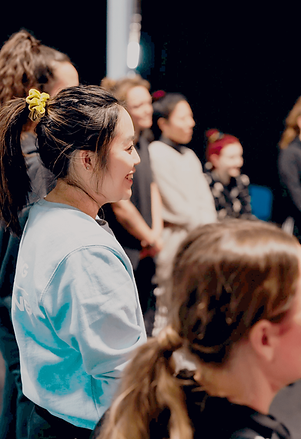Psychological Approach CBT for Pain Treatment
- Bethany Shum

- Aug 6, 2024
- 4 min read
Chronic musculoskeletal pain is a complex issue that often requires a multidisciplinary approach to manage effectively. While physical factors undoubtedly contribute to pain, it's equally important to recognise the significant role of psychological factors in the pain experience.
The acrobatic athlete's perspective on pain
Athletes in physically demanding disciplines like acrobatics and gymnastics often experience a unique relationship with pain. Musculoskeletal (MSK) pain is joint among acrobats, while injuries resulting in pain are common in gymnasts (12) and circus performers (9).
To differentiate pain perception, acrobatic research on circus performers (10) and gymnastic athletes (2) similarly categorised their pain as either good "performance pain" or bad "injury pain" (2) (10). It is difficult to differentiate between the pain from a new and an old injury in acrobats, as it depends on the recuperation period (1). The consequences of an injury or accumulation of injuries may result in retirement (2).
A holistic, multidisciplinary approach to performance and training
Pain is a subjective experience. Psychological factors, therefore, need to be considered when treating chronic musculoskeletal pain (14). Addressing factors such as improving pain self-efficacy (7) and reducing pain catastrophising (6) can help reduce pain intensity.
Guidelines from the National Institute for Health and Care Excellence (NICE) support the use of psychological interventions like Acceptance and Commitment Therapy (ACT) and Cognitive Behavioral Therapy (CBT) for chronic pain management. These therapies help individuals identify stressors, develop coping mechanisms, and align their actions with their values (i.e. what is meaningful to them).
The role of CBT in pain management
Cognitive Behavioral Therapy (CBT) is a well-established psychological intervention for chronic pain. The CBT 5 Area Formulation model offers a structured approach to understanding and addressing pain-related issues and can be highly beneficial (11). This model considers thoughts, emotions, physical sensations, and behaviours as interconnected components of the pain experience.
By breaking down the pain experience into these elements, individuals can gain valuable insights into their pain patterns and develop strategies to manage them effectively. The CBT 5 Area Formulation provides a framework for identifying unhelpful thought patterns, challenging negative emotions, and changing behaviour to improve overall well-being.
[Figure 1 below presents various clinical applications of the CBT 5 Area Formulation model as part of pain management intervention based on literature review findings.]
This proposed model breaks down a pain-related situation into smaller parts, demonstrating the connection between physical and emotional sensations of the body. This is a simple way to identify the thoughts and behaviour patterns of the individual.
This circular diagram illustrates the CBT 5 Area Formulation. The central circle represents the situation: "Living in pain due to an injury or overuse condition", along with the four interconnected psychological themes within the central circle:
1.Thoughts: "No pain, no gain" (3); (4) and (5).
2. Emotions: Pride cited from (5) and depression, anxiety, and stress (3).
3. Physical: Pain and discomfort cited from (8) and (5).
4. Behaviors: Continuing training (8); (14) and ignoring the pain (3).
Conclusion
A holistic approach to pain management is essential for achieving optimal outcomes. By combining physical treatments with psychological interventions like CBT, individuals can develop a comprehensive understanding of their pain and develop effective strategies for managing it. This approach is particularly relevant for athletes who experience high physical stress and psychological pressure to perform.
__________________________________________________________________________________
References
Orlando C, Levitan EB, Mittleman MA, Steele RJ, Shrier I. The effect of rest days on injury rates. Scand J Med Sci Sports. 2011;21(6):e64-e71. doi:10.1111/J.1600-0838.2010.01152.X
Häuser W, Wolfe F, Henningsen P, Schmutzer G, Brähler E, Hinz A. Untying chronic pain: Prevalence and societal burden of chronic pain stages in the general population - A cross-sectional survey. BMC Public Health. 2014;14(1). doi:10.1186/1471-2458-14-352
Baumann A, Banzer W, Fleckenstein J. Biopsychosocial Factors of Pain in 865 Sports Students of the Dach (Germany, Austria, Switzerland) Region-A Cross-Sectional Survey. J Sports Sci Med. 2020;19:323-336. Accessed June 6, 2022. http://www.jssm.org`Prevalenceorg`org`Prevalenceof
Tynan R, McEvilly N.' No pain, no gain': former elite female gymnasts' engagements with pain and injury discourses. http://dx.doi.org.libproxy.ucl.ac.uk/101080/2159676X20171323778. 2017;9(4):469-484. doi:10.1080/2159676X.2017.1323778
Watt C. Social circus in aerials: Female experience, muscularity, pain and trust. https://doi-org.libproxy.ucl.ac.uk/101080/1944392720211968025. 2022;13(1):136-152. doi:10.1080/19443927.2021.1968025
Coates C, McMurtry CM, Lingley-Pottie P, McGrath PJ. The prevalence of painful incidents among young recreational gymnasts. Pain Res Manag. 2010;15(3):179-184. doi:10.1155/2010/617587
Stubbe JH, Richardson A, Van Rijn RM. A prospective cohort study on injuries and health problems among circus arts students. BMJ Open Sport Exerc Med. 2018;4(1). doi:10.1136/BMJSEM-2017-000327
Cayrol T, Godfrey E, Draper-Rodi J, Bearne L. Exploring Professional Circus Artists' Experience of Performance-Related Injury and Management: A Qualitative Study. Med Probl Perform Art. 2019;34(1):14-24. doi:10.21091/MPPA.2019.1004
Gram MCD, Clarsen B, Bø K. Injuries and illnesses among competitive Norwegian rhythmic gymnasts during preseason: A prospective cohort study of prevalence, incidence and risk factors. Br J Sports Med. 2021;55(4):231-236. doi:10.1136/BJSPORTS-2020-102315
Munro D. Injury patterns and rates amongst National Institute of Circus Arts students: an observational study. Med Probl Perform Art. 2014;29(4):235-240. doi:10.21091/MPPA.2014.4046
Trompeter K, Fett D, Platen P. Prevalence of Back Pain in Sports: A Systematic Review of the Literature. Sports Medicine. 2017;47(6):1183-1207. doi:10.1007/S40279-016-0645-3
Nicholas MK. The pain self-efficacy questionnaire: Taking pain into account. Eur J Pain. 2007;11(2):153-163. doi:10.1016/J.EJPAIN.2005.12.008
NICE. Chronic Pain (Primary and Secondary) in over 16s: Assessment of All Chronic Pain and Management of Chronic Primary Pain | Guidance | NICE.; 2021. Accessed June 30, 2022. https://www.nice.org.uk/guidance/ng193/chapter/Context
Lampe J, Groneberg DA, Ohlendorf D, Wanke EM. Pain in female dancers and dance teachers: Perception, assessment, and related behaviour. Scand J Med Sci Sports. 2019;29(4):623-632. doi:10.1111/SMS.13387




.png)





Comments